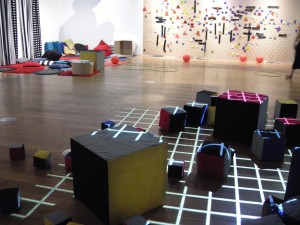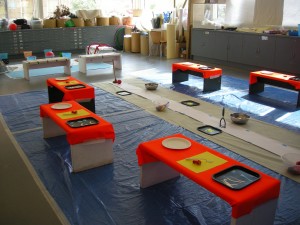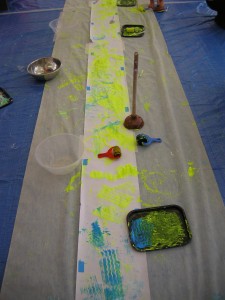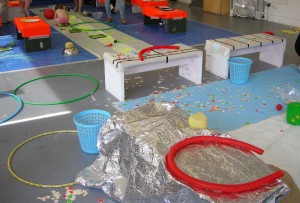For my first blog post, I thought I’d give you some insight into how ‘Creative Baby!’ came about. This is a new monthly group I’ve developed for babies 0-12 months, which combines an exhibition tour, crafting activity, parachute games and songs, and a sensory play space inspired by the exhibition. Although several baby and toddler-focused groups meet at the Shipley, their activities mainly take place in the Lounge, and I wanted to develop something that really engaged babies and parents in our exhibitions.
Thinking about those parents who enjoyed a gallery visit pre-baby and would now like to introduce their baby to gallery-going, I embarked on a research trip to Manchester, where the Museums and Galleries Partnership (The Whitworth, Manchester Museum and Manchester City Galleries) are working collaboratively to highlight innovative, cultural practice with the under-twos. The Culturebabies website tells you more about their exciting work, which takes a really interesting and creative approach to early intervention, language and social development.
At The Whitworth and Manchester Art Gallery I couldn’t stop smiling; my head was buzzing with ideas I couldn’t wait to take back to Gateshead, and everywhere I looked I saw young families being engaged in inspiring ways. At The Whitworth (which has since been awarded Museum of the Year) I was really struck by the Early Years Atelier (meaning ‘workshop’ or ‘studio’); a bright and airy room that not only offers creative activities for families, but smoothly opens out onto a welcoming patio, which seamlessly merges with an extensive public park. I was particularly interested to hear that the Whitworth employs a ‘cultural park keeper’ to help family audiences make the transition from using the park, to exploring inside the museum.
An equally enticing Early Years offer awaited me at Manchester Art Gallery, where I met some of the Learning staff and visited the Mini Art Club, which is just one of the gallery’s many offers for families. I delighted in the Clore Art Studio, where artists Jessica Wild and Sarah Marsh have created a space for families to interact creatively. Here, children and adults alike can explore pattern in exciting and innovative ways, and engage with the themes of the exhibition ‘House Proud’ in a unique and hands-on way. I was so taken with this space I didn’t want to leave; but downstairs more wonder awaited, in the Mini Art Club for 1-4 year olds. This was a place of exploration, furnished with different textures and art materials, all beautifully presented in ways that invited investigative play. The most striking thing was that none of the children were making an artwork to take home; rather they were freely exploring an array of open-ended creative opportunities. Moving about at their own pace, the children were engrossed in using potato mashers to print on the vast rolls of paper covering the floor; observing how ribbons blew out from a fan; delighting in the scrunchy noise of foil; and exploring how voices were altered by whispering through a hosepipe. One boy spent much of the session putting a plastic waste paper bin on his head and peering through its mesh surface; occasionally taking it off and then deciding the world was far more interested when viewed in this way. This was about having a creative experience in the moment and in the gallery; and what a mesmerising experience it was!
I enjoyed talking to staff at Manchester Art Gallery about the Reggio Emilia philosophy that underpins their work with children. Much is written on this approach, and for those interested to find out more I’d recommend reading ‘The Hundred Languages of Children’. The approach puts great emphasis on the child’s environment, which should encourage collaboration, communication and exploration, offering inviting spaces for children to explore their creative interests. The child is the driver of their learning and the adult is the enabler, presenting opportunities for the child to take an investigative approach to the world. The title of the book mentioned above refers to the thinking that there are a hundred potential ‘languages’ through which the child communicates; they use many different creative expressions to show their understanding and interest, and to express themselves. Learning and play are intertwined as the child embarks on discovery through a myriad of creative ‘languages’.
This approach seemed to me the natural way to engage with children, particularly in a creative setting such as the gallery. With a head full of ideas, I returned to the Shipley Art Gallery to get planning. As I embarked on this new venture there were so many unknowns to navigate; How was I going to conduct an exhibition tour that would engage young babies? What should the sensory exploration environment look like? What balance should I strike between facilitated session and free play? Many more questions would emerge as ‘Creative Baby!’ took shape, and it was a creative adventure I was eager to embark on, and one that you can read more about in my next blog post!
For now, I leave you with the poem ‘The Hundred Languages of Children’, by Loris Malaguzzi, Founder of the Reggio Emilia Approach:
The child is made of one hundred.
The child has
a hundred languages
a hundred hands
a hundred thoughts
a hundred ways of thinking
of playing, of speaking.
A hundred.
Always a hundred
ways of listening
of marveling, of loving
a hundred joys
for singing and understanding
a hundred worlds
to discover
a hundred worlds
to invent
a hundred worlds
to dream.
The child has
a hundred languages
(and a hundred hundred hundred more)
but they steal ninety-nine.
The school and the culture
separate the head from the body.
They tell the child:
to think without hands
to do without head
to listen and not to speak
to understand without joy
to love and to marvel
only at Easter and at Christmas.
They tell the child:
to discover the world already there
and of the hundred
they steal ninety-nine.
They tell the child:
that work and play
reality and fantasy
science and imagination
sky and earth
reason and dream
are things
that do not belong together.
And thus they tell the child
that the hundred is not there.
The child says:
No way. The hundred is there.



